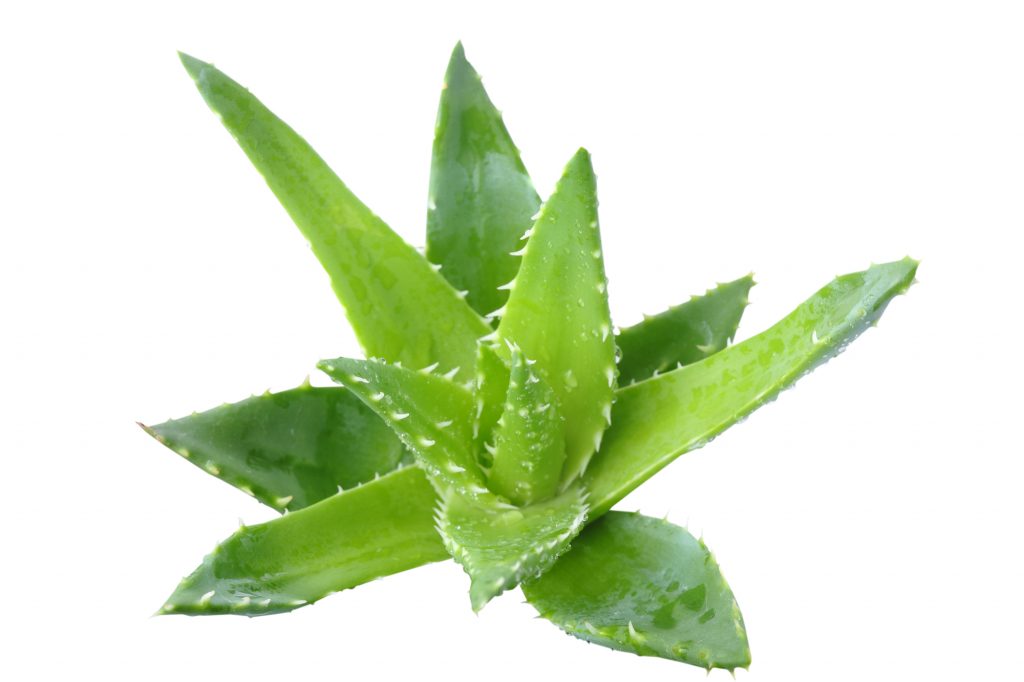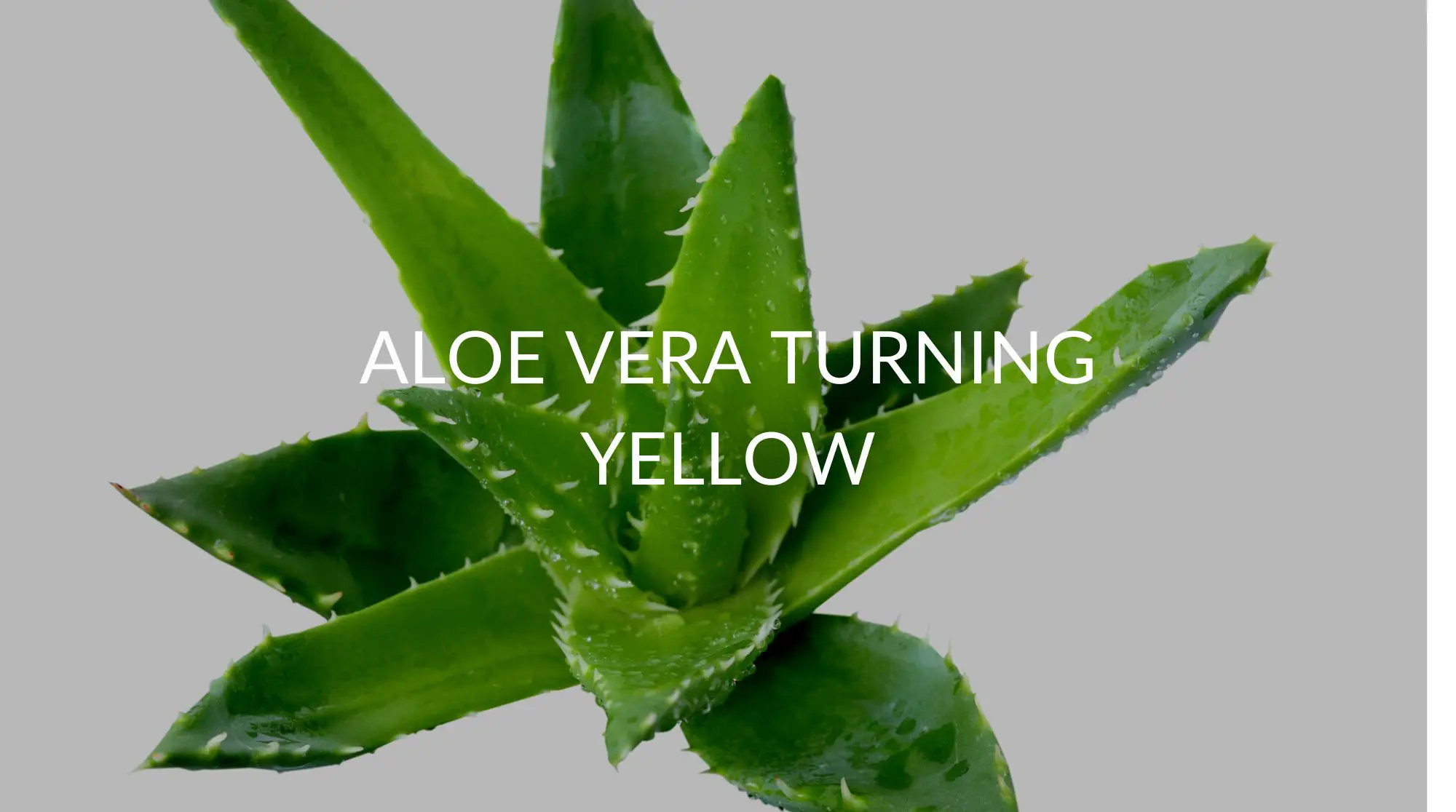Yellowing aloe leaves are most often caused by overwatering. Aloe should only be watered when the top three-quarters of the soil is dry. Other reasons for yellow aloe vera leaves are inadequate drainage, poor soil, exposure to cold, and root rot.
Aloe is a hearty succulent that thrives in a wide variety of conditions, which makes it a great choice for your succulent garden. With its long, bright green leaves, it can add dimension and color to any indoor garden.
It also grows well outdoors if kept away from the bright sun.
Many gardeners even grow aloe to have on hand to soothe minor skin ailments such as burns or scrapes.
Aloes are typically easy to grow, so if you are having problems such as yellow leaves on your aloe, you can probably find an easy fix if you take the time to diagnose the problem.
Read on for guidance on how to figure out what is causing your aloe’s yellow leaves and how to get your plant healthy and green again!
Wondering why your Aloe Vera is turning light green?
Why Is My Aloe Vera Plant Turning Yellow?
Overwatering
The most likely reason your aloe is yellow is overwatering. If you have been a success at growing houseplants and are now growing aloe, you may be overwatering without even realizing it.
Aloe requires much less water than your regular houseplants. It is a succulent, which means it thrives in dry conditions with only infrequent watering. Basically, the roots are designed to absorb a lot of water during each watering and then store that water (hence the plump leaves on most succulents).
If you water frequently, the roots will absorb more water than they can process. This will damage the roots, which will not be able to absorb nutrients, and the leaves will turn yellow.
If you notice mushy or soft spots on your aloe along with the yellow leaves, or if you see that the roots are brown or rotting, overwatering is most likely the culprit.

Inadequate Drainage
Even if you water your aloe on the correct schedule, if the plant is sitting in damp soil, it will eventually develop yellow leaves. Aloe needs a significant amount of drainage, so any excess water will drain off rather than be absorbed by the roots. Aloe does not like “wet feet”–roots sitting in damp soil.
Inadequate drainage can be due to your type of pot, whether it is sitting on a dish and whether it has adequate drainage holes in the bottom.
You may also have your aloe growing in a pot that is too large. Deep, narrow pots tend to retain water more than shallow pots.
Poor Soil
Aloe soil also contributes to drainage. Aloe (and all succulents) needs to be grown in soil that is gritty and has a significant amount of mineral matter, rather than potting soil, which is mostly organic matter. Potting soil retains a large amount of water, which is great for many indoor plants, but succulents will drown in regular soil.
If you haven’t repotted your aloe in many years, it may also be sitting in old soil that is no longer providing adequate nutrition to the plant. Aloe is a desert plant that is used to grow in nutrient-poor soils, but indoor-growing aloe will need to be repotted occasionally.
In addition, if your soil has become compacted or is just a mass around the roots that water cannot penetrate, this can also cause damage to your aloe. Water and air cannot flow into the compacted soil, which will eventually lead to the death of your plant.
Exposure to Cold
Aloe can grow in a range of temperatures, but like many succulents, it cannot tolerate sudden shifts in temperature. It also grows best in a temperature range of 55-80 ℉. If your aloe is outdoors and the temp dips much below this range, the plant will become stressed.
You may notice yellow leaves if your plant has been moved recently as well. Many plants react to stress with yellowing leaves or dropping leaves, and aloe may be the same, especially if it has been moved to a spot that is cooler.
Root Rot
Root rot can be identified by black or brown roots that are soft or mushy to the touch and may have a strong, unpleasant odor. Root rot is most often caused when aloe roots are allowed to sit in water for too long.
This “drowning” of roots means that they are not able to absorb oxygen. This could be due to overwatering, poor drainage, or poor soil. Root rot can also be caused by a fungal infection.
If your aloe has root rot, it will develop yellow or brown leaves, which may have soft or mushy spots. You may also notice that the stem of your aloe is soft to the touch rather than supple and firm like healthy aloe should be.
How To Treat An Aloe Vera Plant That Turned Yellow
Water Your Aloe Correctly
You may be a great houseplant parent, tending to your plants frequently and never forgetting to water them. You may have that wonderful impulse to give your plants everything they could ever want. The problem is that with aloe, less water is sometimes more.
Aloe should only be watered when the soil is dry three-quarters of the way into the pot. You will have to do the touch test to figure out if your soil is dry enough to water. You may also be able to weigh the pot in your hands–some gardeners can tell if the soil is very dry if their plant feels light.
How frequently you water aloe depends on your growing conditions and climate. Aloe growing in very dry conditions with a lot of light may require watering every other week in the summer growing season.
In more humid climates, or if your aloe is growing in lower light, you will want to water less. In the winter time aloe is not growing, so you will only need to water around once a month.
Soak the soil and roots completely, and let the excess drain off. You may need to do this more than once to get all the roots wet. Then you don’t have to do anything until the soil is dry again.
Treat Root Rot
If you do have an overwatered aloe plant, you will need to inspect it for root rot. Pull it very gently out of the pot. If the roots are stuck, you may need to shake it slightly or dislodge the roots with a chopstick. If the roots are very damaged, you may notice that they fall apart or detach from the plant entirely.
Roots should be white, dry, and firm. If yours look brown, black, or mushy, that is root rot.
You can trim away the dead roots with sterile scissors (you can use rubbing alcohol or peroxide). Make sure you don’t cut healthy roots with contaminated scissors.
If your roots are very compromised, you may want to just cut away the healthy parts and repot those alone to regrow. Aloe doesn’t need a lot of roots to propagate, but it will take some time to regrow your plant.
If you have root rot, it is a good idea to disinfect your pot or use a new pot since root rot can be caused by a fungal infection.
Choose a New Pot
The type of pot you are growing your plants in makes a difference. For succulents, you want a pot that allows excess moisture to evaporate rather than to trap it in the soil. This is especially important in humid environments.
Plastic, glass, metal, or glazed decorative pots may not allow your soil to dry out completely between waterings. Terracotta pots are typically a good choice when growing succulents since they allow for good airflow and evaporation.
Make sure your pot has at least one drainage hole in the bottom. Larger pots should have more than one to ensure even draining. Never leave your aloe sitting in a dish of water. If your plant is outdoors, move it out of the rain if you feel the soil is not draining adequately.
If your aloe is growing in a very deep pot, your soil may be retaining too much water in between waterings. Succulents are best grown in small, shallow pots. With tall succulents, such as aloe and snake plants, you may want to anchor the plant in a wide pot, so it doesn’t get top-heavy and tip.
Use Succulent or Cactus Soil
Aloe requires soil with excellent drainage. That potting soil you use for your other house plants just isn’t cut it. Potting soil retains too much moisture, which will drown the roots of your aloe or other succulents.
Premixed succulent or cactus soil is great for aloe. Make sure whatever soil you use looks gritty and coarse to the touch and does not contain a lot of extra organic material like leaf debris or compost (this material will retain water).
You can even mix up your own soil with roughly one-third potting soil and two-thirds mineral material like coarse sand, perlite, pumice, lava rock, or gravel. Succulent soil will require the nutrients in the potting soil but also the drainage provided by inorganic materials.
Move to a Bright Location
Aloe may get sunburned if it is growing in very strong, hot sun for long hours, but otherwise, it thrives in bright, indirect light. If you are growing your aloe in very low light, that may be the reason it isn’t thriving.
Move to a bright window for at least a few hours everyday. You can also put your aloe outdoors, though make sure it doesn’t get too much sun. Aloe can actually get sunburned.
If you don’t have adequate bright light, you can use a grow light with succulents.
Keep Away From Cold
Succulents are designed to live in harsh, variable environments, but that doesn’t mean that they can tolerate abrupt changes in temperature or light. If your aloe was exposed to extremely cold temperatures, it may be in shock and will take a little time to recover.
Check to make sure your aloe is in a location where the temperature doesn’t dip below 55℉. If it is by a drafty window, door, or AC vent, it may be getting too much cold air.
If you are moving your aloe from low light to a brighter location, you may want to expose it to the brighter light a little at a time. Maybe a few hours per day until it has adjusted to the brighter light. Aloe can tolerate some bright sun during the day, but make sure the leaves don’t look washed out and sunburned.
Can Yellow Aloe Vera Turn Green Again?
Often, yes. Once the roots are returned to health, they can more readily absorb nutrients and keep the plant looking healthy and green.
If you follow the steps above, a plant that has not been left for too long can usually recover. Try to make sure your aloe has the best conditions for its healing–make sure it gets enough light, and don’t overwater.
If your plant has been yellowing for a long time, however, or if you see that there are large patches of root rot, you may not be able to revive your plant. If your plant is very damaged, try to cut away the healthy parts and plant them separately.
You can also propagate aloe from a cutting of the stem. If there is a healthy, firm part of the stem, cut that away and let the wound heal for a week or so. Then plant in succulent soil and give it bright light but not sun. You may be able to grow a new aloe plant.
Some gardeners propagate aloe from leaf cuttings, though this is often difficult. If you have healthy green leaves, cut them off (use clean scissors) and then let the wounds heal. You can try to root them in soil just as you would a stem cutting.
How To Prevent Aloe Vera Plants From Turning Yellow?
Don’t Overwater
The most important thing is to figure out what watering frequency your aloe needs. Only water when the soil is very dry. When in doubt, it is better to underwater a succulent than overwater it.
Repot Every Two Years
Succulents such as aloe grow well in desert soils that are not rich in nutrients. That being said, gardeners have found that repotting your plant every two years or so will give it what it needs to be a healthy houseplant. Plus, it will allow you to inspect the roots and remove any damage.
Don’t use a new pot that is too big. Just go up one size from what you have if you need to upgrade. Try to find a shallow pot rather than something deep. Sometimes Bonsai pots make nice planters for aloe.
Your aloe may be in shock for a little while after repotting, but if it is getting enough light, warm temps, and adequate water, it should recover fairly quickly.
Use Succulent or Cactus Soil
It is imperative that you use well-draining soil for aloe. If you are making your own soil, make sure it is at least half gritty texture, such as coarse sand or gravel. When in doubt, err on the side of adding more coarse material and a smaller amount of potting soil.
Avoid Cold Temperatures
If your aloe is growing outdoors, make sure you bring it in before the temperature dips below 55℉. Some other houseplants can tolerate temps down to almost freezing without too much trouble, but make sure to bring your aloe in if the temperature is dropping.
Fertilize
Aloe often grows very well without any fertilizer, so you don’t have to add it. Aloe is sensitive to chemical and salt buildup, so it is easy to over-fertilize.
After you have taken care of any root rot issues, you can fertilize your aloe with succulent fertilizer in the growing season (never in winter). If your plant has damaged roots, they will need to heal before you add any fertilizer.
FAQ
Why Is My Aloe Plant Turning Yellow At The Tips?
Yellow or brown aloe tips mean something is wrong with your watering regimen. Only water when the soil is three-quarters dry. Never let it dry out completely. Aloe may only need water once a month to survive.
Make sure the pot has drainage holes and you are using coarse soil. You can add pumice or perlite to the soil to increase drainage.
Recap
If your aloe is yellow, don’t panic, but definitely try out these strategies to determine the problem. If your plant is otherwise healthy, you should be able to nurse it back to its spiky green beauty.
If you are overloving your aloe by overwatering, try to resist the temptation! You can give your aloe plenty of attention, just don’t give it too much water!







